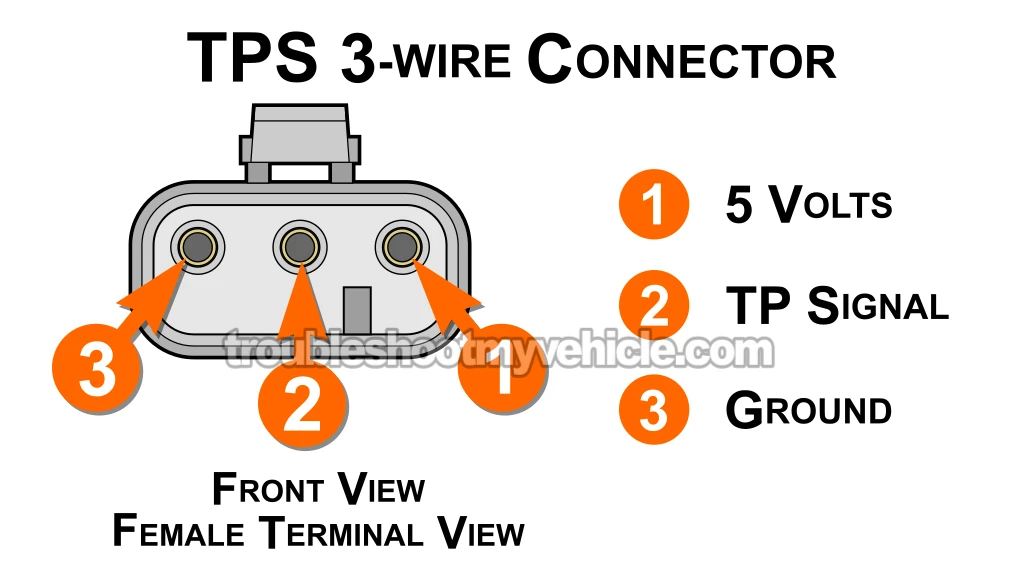TEST 2: Making Sure The TPS Is Getting Power

If you've reached this test step, you have confirmed that in TEST 1 your multimeter DID NOT register an increasing/decreasing throttle angle voltage signal.
Now, we need to make sure that the throttle position sensor (TPS) is getting power.
Power comes in the form of 5 Volts DC from the PCM and is fed to the sensor via the violet with white stripe (VIO/WHT) wire of the TP sensor harness connector.
Once we've confirmed that the sensor is in fact getting power (5 V), then the next step is to make sure it's getting Ground (TEST 3).
OK, let's get started:
- 1
Disconnect the TP sensor from its connector.
- 2
Connect the black multimeter test lead directly on the battery's negative (-) terminal.
- 3
Set your multimeter to Volts DC mode.
- 4
Gently probe terminal 1 (of the 3-wire connector) with the red multimeter test lead.
NOTE: Double-check that the VIO/WHT wire connects to terminal number 3. - 5
Have a helper turn the key to the ON position, but don't crank or start the engine.
- 6
Your multimeter should register 4.5 to 5 Volts DC.
Let's take a look at what your test results mean:
CASE 1: The VIO/WHT wire has power (4.5 to 5 Volts). This is the correct and expected test result and tells you that the throttle position sensor (TPS) is getting power.
Your next step is to make sure that the TPS is getting Ground on the black with light blue stripe (BLK/LT BLU) wire. For this test, go to: TEST 3: Making Sure The TPS Is Getting Ground.
CASE 2: The VIO/WHT wire DOES NOT have power (4.5 to 5 Volts). Re-check your multimeter test lead connections and re-test.
If the multimeter still indicates the TPS is not getting power, then you've found the reason why the TPS did not create a voltage signal in TEST 1.
Although it's beyond the scope of this tutorial to find the reason why these 5 Volts are missing, you'll need to get yourself a wiring diagram (for your particular Dodge Ram pickup) and check the continuity of this wire between the TPS and the PCM.
TEST 3: Making Sure The TPS Is Getting Ground

Your TPS troubleshooting test results have confirmed that:
- The TP sensor IS NOT creating an increasing/decreasing throttle plate voltage signal on the ORG/DK BLU wire (TEST 1).
- The VIO/WHT wire of the TPS harness connector is feeding the TP sensor with power (TEST 2).
The last test is to make sure that the black with light blue stripe (BLK/LT BLU) wire is feeding the TPS with Ground.
NOTE: Be careful and do not short this wire directly to battery voltage, or you'll fry your Dodge Ram pickup's PCM.
These are the test steps:
- 1
Disconnect the TP sensor from its connector.
- 2
Connect the red multimeter test lead directly on the battery's positive (+) terminal.
- 3
Set your multimeter to Volts DC mode.
- 4
Gently probe terminal 3 (of the 3-wire connector) with the black multimeter test lead.
NOTE: Double-check that the BLK/LT BLU wire connects to terminal number 1. - 5
Have a helper turn the key to the ON position, but don't crank or start the engine.
- 6
Your multimeter should register 10 to 12 Volts DC if the BLK/LT BLU wire is feeding the throttle position sensor (TPS) with Ground.
Let's take a look at what your test results mean:
CASE 1: The multimeter registered 10 to 12 Volts DC. This test result confirms that the TPS is getting Ground. Now, since you have:
- Confirmed that the TPS is not creating a throttle plate angle voltage signal (TEST 1).
- Confirmed that the VIO/WHT wire is providing power (TEST 2).
And in this test step you have confirmed that the throttle position sensor is getting Ground then you can conclude that the reason its not creating a throttle plate angle signal is because it is defective and needs to be replaced.
If you'd like to save a few bucks on the TP sensor, check out the section: Where To Buy The TPS And Save.
CASE 2: The multimeter DID NOT register 10 to 12 Volts DC. Re-check all of your test connections and repeat the test.
If the multimeter still does not show the indicated voltage, then you've found the reason why the TPS did not create a voltage signal in TEST 1.
Although it's beyond the scope of this tutorial to find the reason why this Ground is missing, you'll need to get yourself a wiring diagram (for your particular Dodge Ram pickup) and check the continuity of this wire between the TPS and the PCM.
More 5.2L, 5.9L V8 Dodge Ram Pickup Diagnostic Tutorials
I've written quite a few 5.2L, 5.9L Dodge Ram Pickup 'how to test' tutorials that may help you troubleshoot the issues on your Dodge Ram pickup. You can find them in these two indexes:
Here's a small sample of the articles/tutorials you'll find in these indexes:
- How To Test A No Start Condition (Dodge 3.9L, 5.2L, 5.9L).
- How To Diagnose Misfire Codes (Dodge 3.9L, 5.2L, 5.9L).
- How To Test The Fuel Injectors (Dodge 3.9L, 5.2L, 5.9L).
- How To Test The Ignition Coil -No Start Tests (Chrysler 3.9L, 5.2L, 5.9L).
- How To Test The MAP Sensor (P0107, P0108) (Dodge 3.9L, 5.2L, 5.9L).

If this info saved the day, buy me a beer!

